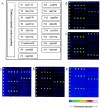Detection of gyrA and parC mutations associated with ciprofloxacin resistance in Neisseria gonorrhoeae by use of oligonucleotide biochip technology
- PMID: 15583317
- PMCID: PMC535257
- DOI: 10.1128/JCM.42.12.5819-5824.2004
Detection of gyrA and parC mutations associated with ciprofloxacin resistance in Neisseria gonorrhoeae by use of oligonucleotide biochip technology
Abstract
An oligonucleotide biochip that specifically detects point mutations in the gyrA and parC genes of Neisseria gonorrhoeae was designed and subsequently evaluated with 87 untreated clinical specimens. The susceptibilities of the N. gonorrhoeae strains were tested to determine the prevalence of ciprofloxacin-resistant strains in Anhui Province, People's Republic of China. Conventional DNA sequencing was also performed to identify mutations in gyrA and parC and to confirm the biochip data. The study demonstrates that all of the point mutations in the gyrA and parC genes of N. gonorrhoeae were easily discriminated by use of the oligonucleotide biochip. Fifteen different alteration patterns involved in the formation of ciprofloxacin resistance were identified by the biochip assay. Double mutations in both Ser91 and Asp95 of the GyrA protein were seen in all nonsensitive isolates. Double mutations in Ser91 and Asp95 of GyrA plus mutation of Glu91 or Ser87 of the ParC protein lead to significant high-level resistance to ciprofloxacin in N. gonorrhoeae isolates. The results obtained by use of the oligonucleotide biochip were identical to those obtained by use of DNA sequencing. In conclusion, the oligonucleotide biochip technology has potential utility for the rapid and reliable identification of point mutations in the drug resistance genes of N. gonorrhoeae.
Figures

References
-
- Alcala, B., L. Arreaza, C. Salcedo, I. Antolin, N. Borrell, J. Cacho, C. De Las Cuevas, L. Otero, G. Sauca, F. Vazquez, H. Villar, and J. A. Vazquez. 2003. Molecular characterization of ciprofloxacin resistance of gonococcal strains in Spain. Sex. Transm. Dis. 30:395-398. - PubMed
-
- Belland, R. J., S. G. Morrison, C. Ison, and W. M. Huang. 1994. Neisseria gonorrhoeae acquires mutations in analogous regions of gyrA and parC in fluoroquinolone-resistant isolates. Mol. Microbiol. 14:371-380. - PubMed
-
- Booth, S. A., M. A. Drebot, I. E. Martin, and L. K. Ng. 2003. Design of oligonucleotide arrays to detect point mutations: molecular typing of antibiotic resistant strains of Neisseria gonorrhoeae and hantavirus infected deer mice. Mol. Cell. Probes 17:77-84. - PubMed
-
- Call, D. R., M. K. Borucki, and F. J. Loge. 2003. Detection of bacterial pathogens in environmental samples using DNA microarrays. J. Microbiol. Methods 53:235-243. - PubMed
-
- Cheung, V. G., M. Morley, F. Aguilar, A. Massimi, R. Kucherlapati, and G. Childs. 1999. Making and reading microarrays. Nat. Genet. 21:15-19. - PubMed
Publication types
MeSH terms
Substances
LinkOut - more resources
Full Text Sources
Other Literature Sources
Molecular Biology Databases

